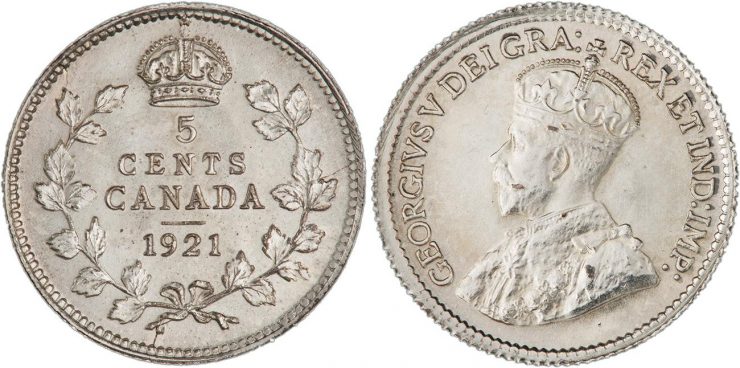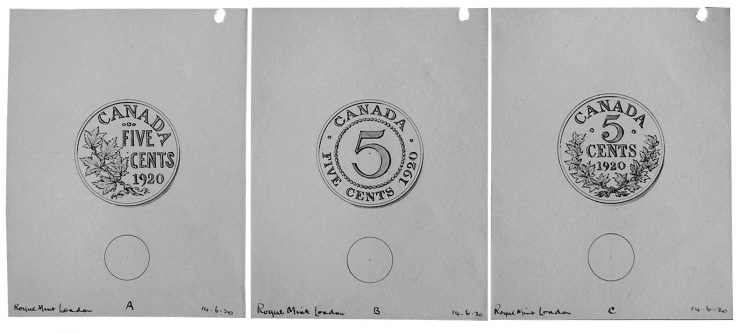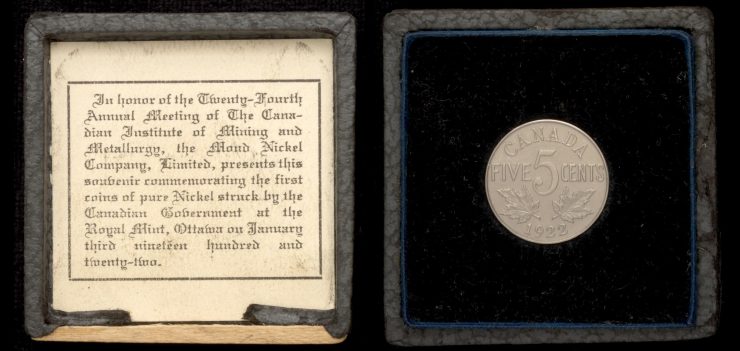The first Canadian nickel
The first Canadian nickel
From 1858 to 1921, the Canadian 5-cent coin was made of silver. To maintain silver content that is proportional to its value—meaning that it had to contain 5-cents worth of silver—the coin was quite small, measuring 15.5 millimetres and weighing 1.16 grams. Because of their small size, these coins were often called “fish scales.” Yet, their purchasing power was significant. So losing these little coins was problematic.

With the imminent release of a new 5-cent coin made of nickel, nearly 2.6 million 1921 silver 5-cent pieces were melted down, leaving only about 400 in existence. 5 cents, Canada, 1921 NCC 1972.065.002
By 1920, changes in Canadian coins were on the horizon. The size of the 1-cent coin was reduced to save on the cost of copper. And, in response to the rising cost of silver, the amount of silver in the 5-, 10-, 25- and 50-cent pieces was reduced from 92.5 per cent to 80 per cent. At the same time, there were proposals to mint Canadian coins out of cheap and abundant nickel. After all, Canada was the largest producer of nickel in the world. The 5-cent coin was the logical choice to modify because of its troublesome size. Besides, the United States had already been using nickel in the content up of its 5-cent coin since 1913: the famous buffalo nickel.
The Deputy Master of the Ottawa branch of the Royal Mint, Arthur H. W. Cleave, wrote to the Royal Mint in England on behalf of the Minister of Finance. He requested the creation of new designs for a larger coin to be made of nickel. Of the four designs proposed, the Minister of Finance, Sir Henry Drayton, chose one that was most similar to the smaller 1-cent coin that had recently been introduced. The denomination of the coin was stamped between two maple leaves and the date in the exergue (empty area below the main design of a coin).

These images were submitted to the Finance Minister for approval but were rejected. Library and Archives Canada, Finance Dept fonds (RG19 V.423)
With a design in hand, all that was left to do was find the nickel blanks (discs that coin designs were stamped on) needed to mint the coins.
It was required that the nickel be from Canadian sources—no problem.
The coin blanks also had to be manufactured in Canada—problem.
No Canadian firm was equipped to refine the nickel and manufacture the blanks for minting the new coins. So, the Department of Finance had to relax its criteria to allow the blanks to be produced in either the United Kingdom or the United States. Of the three companies that submitted bids—The British America Nickel Corporation, The International Nickel Company and the UK‑based Mond Nickel Company Limited—Mond won the contract. The initial run required 5 million blanks, amounting to about 50,000 pounds of nickel. On January 3, 1922, the new nickel 5-cent coins went into circulation.
Over the years, the design of the “nickel” has changed several times and so has its metal content. In fact, since 1982, Canadian nickels have contained progressively less and less nickel, going from 25 per cent in 1982 to nickel-plated steel in 2000.
It’s hard to believe, but even nickel has become somewhat of a precious metal commodity!

An uncirculated Canadian 5-cent coin in a presentation case from the Mond Nickel Company, which supplied the Ottawa branch of the Royal Mint with the blanks to mint the coins. 5 cents, presentation case, Canada, 1922 NCC 2013.022.004







